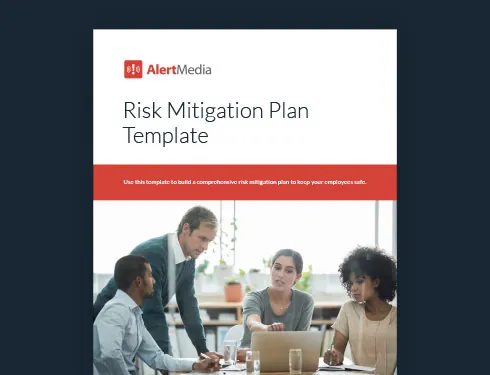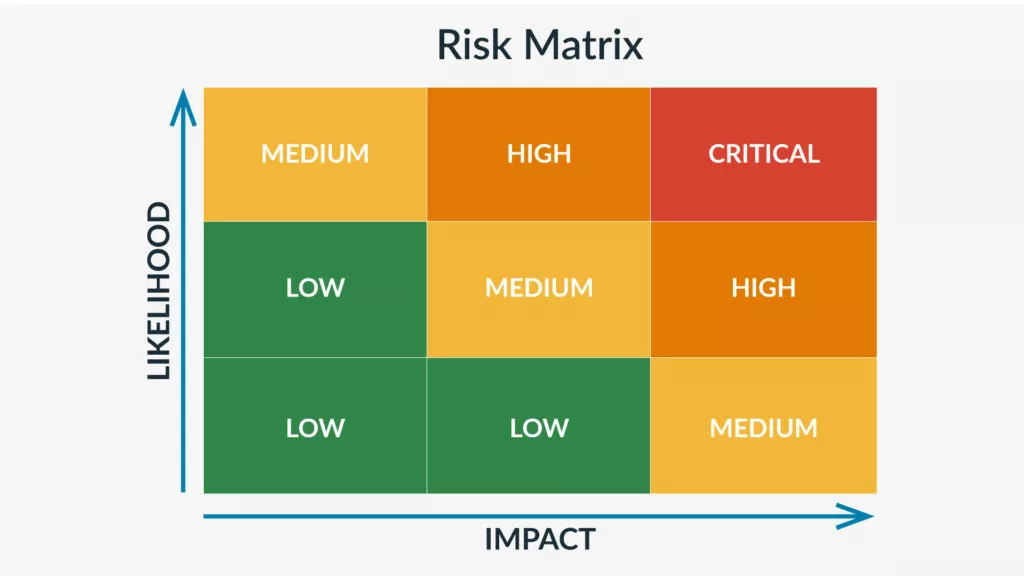![9 Risk Mitigation Strategies for 2024 [+ Examples]](https://www.alertmedia.com/wp-content/uploads/2022/12/9-Risk-Mitigation-Strategies-Blog-Image-V1-1024x536.jpg)
9 Risk Mitigation Strategies for 2024 [+ Examples]
Eliminating all risks to your business may not be possible, but that doesn’t mean you have to roll over and accept defeat. Taking steps to mitigate risk is as close as you can get to full protection, and we’ve got nine strategies to help you out.

As winter approaches, businesses across most of the country will face potential disruptions. Employees may be unable to go to work safely, supply chains will slow, and power outages can bring operations to a halt.

Seasonal conditions can have an outsized impact on business continuity, but they’re just one type of operational risk. Companies must contend with weather and natural disasters, occupational hazards, cybersecurity threats, and myriad other potential risks. Taken together, managing and mitigating risk is a year-round priority. A Deloitte survey of executives found that 94% of respondents believe risk management is becoming more important to achieving strategic goals.
Risks come in a variety of forms, and there’s no perfect way to address them. But with planning and preparation, you can minimize the threat to your business. This article will go through nine risk mitigation strategies and examples of how you can implement them.
What Are the Four Types of Risk Response?
If you walked into your office break room and found a toaster on fire, your next moves would be obvious. You’d grab a fire extinguisher, put out the fire, tend to any injuries, and report the incident for cleanup. While this is a simple scenario, it’s an ideal example of risk response. You identified a risk (a fire) and issued an immediate response (extinguishing it).
Most risks your company will face aren’t so simple. That’s where strong organizational risk intelligence comes in. By developing the ability to identify, understand, evaluate, project, assess, and respond to identified risks, you can prepare your team for nearly any threat.
No single step is more important than the others. But risk response is the make-or-break moment when you put training into action and—hopefully—prevent a hazard from injuring your team members or operations. There are four types of risk response:
- Risk avoidance: Sometimes, the best risk response strategy is to eliminate the threat altogether. For example, if employees are traveling into the path of an oncoming hurricane, canceling their trip would avoid that risk.
- Risk transference: You can share or transfer certain types of risk such that you wouldn’t bear the impact alone. Insurance is a form of risk transference, as you pay a small fee to a third party to avoid the full financial brunt of things like car accidents.
- Risk acceptance: When a risk is small enough, it might make sense to just live with it. For example, if you’re planning an outdoor event with a 2% chance of rain, accepting that very small risk might make more sense than rescheduling. For threats that bring a higher potential impact, you need to determine your acceptable level of risk.
- Risk mitigation: Many types of risk are neither avoidable nor acceptable. But you can mitigate safety and business risks by reducing their likelihood of occurring and/or the impact they could have. For example, an industrial bakery can’t avoid having massive heat sources active, but they can take steps to reduce the danger to employees and property.
Download Our Risk Mitigation Plan Template
Risk Mitigation Planning
In an ideal world, you could prepare your organization for any and every threat it may face. In reality, you have limited time and resources to dedicate to your risk management plan.
The key to risk mitigation planning is to focus on how likely a threat will come to fruition and how much it would impact your business. A risk matrix can be a helpful tool for visualization and prioritization based on a combination of factors:

Using this matrix, you would begin with the highest risk level and then work your way down the list, addressing low risks as time and resources allow.
For example, consider an Alaskan king crab boat that regularly works in rough seas and the following possible risks:
- A crewmember going overboard: Given the crew’s working conditions, there’s a high likelihood of this happening. The impact of the risk is high as well, as an incident could potentially lead to death. This is a critical risk and would be a top priority to focus on mitigating.
- GPS equipment breaking: As long as they maintain their electronics, the likelihood of this happening is low. But an equipment failure would have a moderate impact, as the crew would need to navigate using methods with higher margins of errors, possibly delaying travel. This would be a medium-level risk, and mitigating it would be wise.
- Eggs breaking in the kitchen: In rough conditions, waves can be unpredictable, and eggs could easily end up cracked, so there’s a moderate likelihood of this happening. However, the impact is low, as the crew would almost certainly have other food to eat. This is a low risk, and you can ignore it in favor of more pressing concerns.
9 Risk Mitigation Strategies & Examples
The risk mitigation process isn’t a one-size-fits-all endeavor. Once you perform a threat assessment and start understanding how to manage your risks, you’ll find that different situations call for different approaches.
Here are nine common risk mitigation strategies you can implement to handle various challenges your business could face.
1. Challenge the risk
Strategy: You can see some risks ahead of time and monitor them as they evolve. Challenge these risks by allowing them to progress as long as the danger is manageable and negligible. Then cut or slow them before the hazard becomes substantial.
Example: Weather forecasts aren’t perfect, but snowstorms are reasonably predictable. You can challenge the risk by staying open in the days leading up to an impending storm, then closing operations with enough time for your employees to make it home safely.
2. Prioritize your risks
Strategy: A single hazard can pose multiple risks to your business and team. When this happens, you can minimize the impact by prioritizing the risks and dealing with them in order of importance.
Example: If you’re responsible for the business continuity plan at a hospital in New Orleans, a hurricane is the sort of threat that keeps you up at night. Prioritizing your risks will speed up decision-making in an emergency. First, you’d ensure patients are cared for and employees are safe. Then, you’d use the remaining time and resources to minimize damage to your facilities and equipment, starting with expensive or hard-to-replace machinery and leaving things like office furniture for last.
3. Exercise the risk
Strategy: Since risks are hazards you’ve already identified, you can exercise them. Run experiments, drills, or tabletop exercises to model threats your team could face and evaluate the effectiveness of your action plans.
Example: Fire drills may have been a pleasant distraction in school—for businesses, they’re a valuable tool for managing risk. By measuring the time it takes people to fully evacuate and assessing any challenges they faced, you can minimize the risks they’ll face in the event of an actual fire.
4. Isolate the risk
Strategy: Businesses engage in a variety of inherently dangerous but necessary activities. You might not be able to alter the risk itself, but by isolating it from other aspects of operations, you can minimize the impact if something goes wrong.
Example: Risk isolation is one of the foundational strategies of cybersecurity. A public-facing server carries certain inherent risks—anyone can access it and attempt to hack it. But you can minimize the potential of that happening by putting your database, file servers, and other valuable resources behind a firewall.
5. Buffer the risk
Strategy: Sometimes, you can minimize risks by adding extra resources to the situation, whether it be time, money, or personnel. Buffering a risk reduces the chances of a negative outcome and makes undertaking the activity more manageable.
Example: Using a crane to hoist heavy equipment to the roof of a building presents a variety of hazards to both people and property. However, you can buffer most of them. In this case, you could build extra time into the schedule, train and place spotters on both the ground and the roof, provide ample instructions, and have plenty of hands on-deck to guide the equipment to its final destination.
6. Quantify the risk
Strategy: Any given risk has a potential cost and a potential reward. To determine whether the positives are enough to justify the potential impact of the risk, you’ll need to quantify, analyze, and compare both sides. Note also that the risk or the reward may evolve throughout the activity.
Example: Many pizzerias rely on deliveries to sustain their business. Thus, having to cut them off can be disastrous for profitability. Sending a driver out in light rain to make a full night of deliveries is likely worthwhile; revenue will be high, and the risk remains low as long as they drive carefully. Conversely, sending them out for a single delivery in a snowstorm is a bad idea—the reward is low, and there’s a much higher chance of a negative outcome.
7. Monitor the risk
Strategy: Hazards and the risks they present aren’t always static. Use a two-way communication solution to monitor conditions affecting your employees and facilities, push out urgent updates, and field requests for help or information.
Example: Employees at restaurants, coffee shops, and retail outlets often face rapidly evolving situations in times of civil unrest. A two-way communication system allows you to get up-to-the-minute updates from employees and provide immediate support on whether they should shelter in place, evacuate, or wait for help from law enforcement.
8. Develop contingency plans
Strategy: Even the best-laid plans often go awry. Even if you think you have a hazard handled, consider its impact and whether a backup plan can reduce the risk even further.
Example: Contingency plans are a key element of travel risk management. If you need to send people into regions where their plans are likely to change due to natural disasters, poor infrastructure, or unexpected circumstances, having backup arrangements can minimize the risks involved in the trip.
9. Leverage best practices
Strategy: Life occasionally throws curveballs, but most of the risks your company faces won’t be novel. Rather than reinventing the wheel, leverage the best practices that groups like the Occupational Safety and Health Administration (OSHA) and International Organization for Standards (ISO) have developed for common operational risks.
Example: Construction technology continues to evolve, but most inherent risks are decades old. OSHA provides standards, training programs, and resources to help mitigate most of the risks involved in the industry. You can implement all of those without extensive research or experimentation.
Putting Risk Mitigation Plans Into Action
Risk reduction is an ongoing journey for any organization. Operations will change, new risks will evolve, and your risk management plans will need to grow accordingly.
Using the strategies covered in this article, you can work with key stakeholders to train your team, document your risk mitigation plan’s effectiveness, and refine it over time. Life will never be hazard-free, but with sufficient planning and practice, you can rest easy knowing you’ve minimized the threats your team faces.

![4 Steps to Conduct a Business Threat Assessment [+ Template]](https://www.alertmedia.com/wp-content/uploads/2022/07/Blog-Image-Business-Threat-Assessment-V1.jpg)


